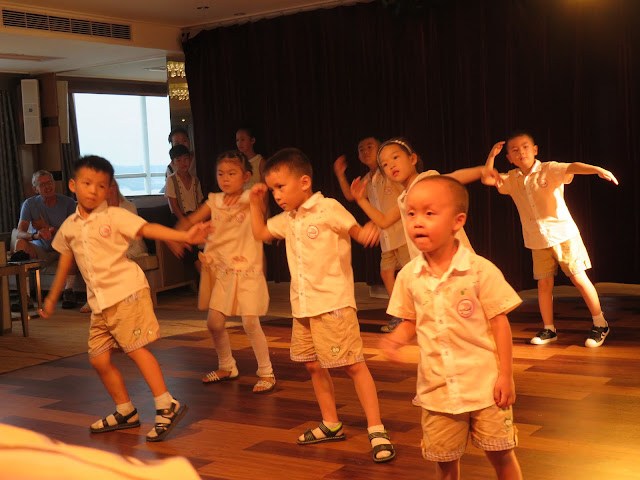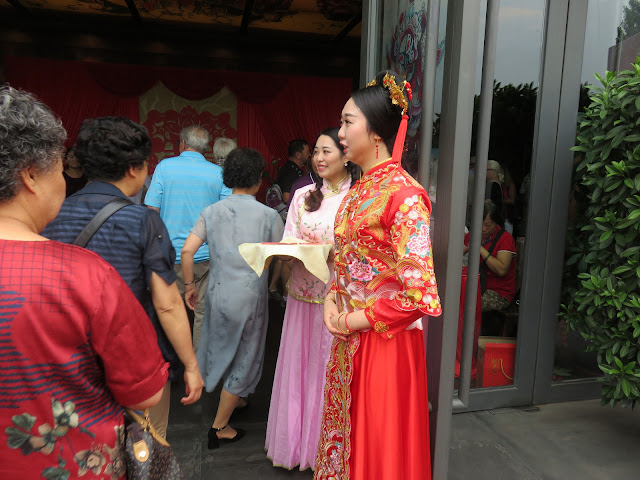 |
| The view from our hotel room on the 37th floor in Shanghai - lots of modern architecture and not as much smog as we expected. |
 |
| A park in Shanghai - lots more green space than we expected, too. |
 |
| Line up for the Shanghai Museum - 5,000 years of China's history |
 |
| Display of Chinese clothing and costumes through the ages |
 |
| Display of ancient Chinese figurines |
 |
| Elaborate furniture and silk screens |
 |
| Extremely detailed ancient Chinese furniture - incredible workmanship |
 |
| Roosters - a symbol of luck |
 |
| Ancient Chinese figurines |
 |
| Ming vase |
 |
| Buddha |
 |
| Demonstration of silk embroidery |
 |
| An amazing silk embroidery picture - incredible amount of work (and extremely expensive) |
 |
| Most people in the city live in apartments. An air conditioner is a must in the sweltering heat and humidity. Many hang their laundry on the balcony to dry. |
 |
| Shanghai Acrobatic Troupe |
 |
| Incredible acts of contortion, trapeze tricks, balancing, etc. It was amazing! |
 |
| The Bund - the promenade along the Huangpu River. The one building is the centre is referred to as the "bottle opener". It definitely looks like one. |
 |
| View of Shanghai's modern cityscape |
 |
| Old Shanghai |
 |
| Using an app on your phone you can rent a scooter or bicycle for as long as you need. You just drop it off at designated spots when you are finished. |
 |
| The vehicle that looks like a bus is actually a police vehicle. These are located all over Shanghai. Some are manned; some merely have cameras. |
 |
| Yuyuan Garden in old Shanghai - the Crooked Bridge. The Garden was first built in 1559. |
 |
| Yuhua Hall |
 |
| Inner Garden |
 |
| This is where we boarded our Viking Cruise boat for our trip down the Yangtze River. |
 |
| Wuhan at night |
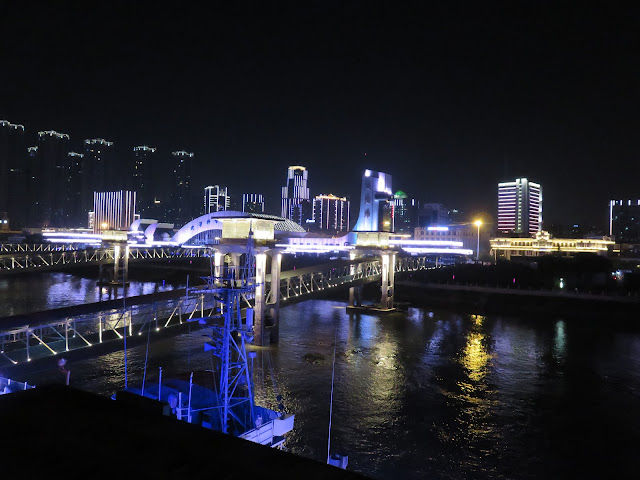 |
| Beautiful lights of Wuhan at night |
 |
| Following the Museum tour we enjoyed a concert by these musicians using reproductions of the famous Hubei bells. |
 |
| Our room aboard the Viking Emerald |
 |
| Leaving the harbour at Wuhan. Transport boats like this one carrying sulphur, coal, gravel, containers, etc. sailed up and down the Yangtze River - a watery highway. |
 |
| The girls' turn to perform |
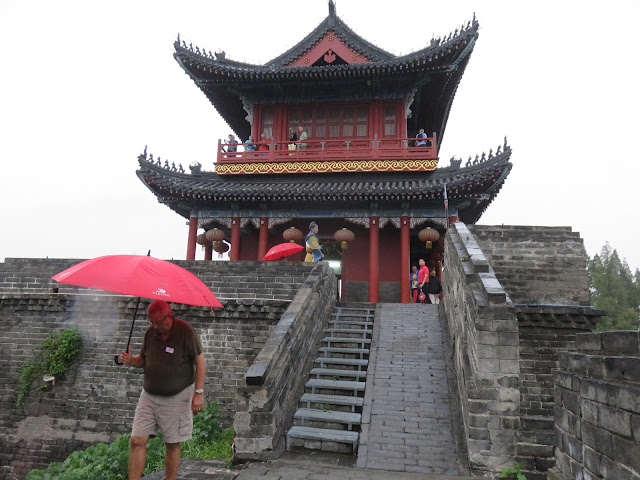 |
| Visiting the Jingzhou watchtower and walls in the rain |
 |
| The city wall in Jingzhou |
 |
| A performance by several members of the crew - a very talented group of young people |
 |
| Four boats squeezed into this narrow lock at the Gezhouba Dam. From the boat we could reach out and touch the wall of the lock. It took less than half an hour for the lock to fill with water. |
 |
| As soon as the lock had filled, off we went down the Yangtze River. |
 |
| The most beautiful section of the Yangtze River is the Three Gorges. The Xuling Gorge is nearly 50 miles in length. |
 |
| Sailing the Yangtze |
 |
| To get to the viewpoint of the dam, we rode escalators to the top. |
 |
| View from the top |
 |
| The concrete and steel dam is almost 8,000 feet long and 600 feet high. |
 |
| One of the sampans on the Goddess Stream |
 |
| The water on the river was quite low at this time of the year. |
 |
| One of the many bridges across the Yangtze. |
 |
| One of the farms along the Wu Gorge which is 25 miles in length. |
 |
| Writings on the cliff walls |
 |
| We docked at the base of Shibaozhai Hill and were amazed to see people washing their clothes at the base of the stairs. |
 |
| Traditional boat |
 |
| One of the people from the boat hitched a ride up the hill (for a fee, of course). |
 |
| The drunken bridge - it doesn't sway or swing; it rolls. You have to take this bridge to get to the Shibaozhai Temple. |
 |
| View of the temple from the top of the pavilion. |
 |
| View of the drunken bridge (look how long it is!!!) and the village from the top of the pavilion. |
 |
| Some of the characters found inside the temple. |
 |
| Unusual buildings, statues, etc. could be seen on the hillsides. |
 |
| A Chinese sunset |
 |
| Their remote location and the fact that they are built well into the cliff meant they were protected from the anti-religious vandalism that occurred during the Cultural Revolution. |
 |
| Golden Hands Buddha |
 |
| The toilet technology was amazing. Who knew you could do all these things while sitting on the can? I know, TMI!! |
 |
| Buildings are constructed without the use of nails to make it more earthquake-proof. |
 |
| Back in Lijiang, we went for a walk around Black Dragon Lagoon. |
 |
| Meat for sale - the long legs at the top once belonged to goats. |
 |
| Every kind of egg you can possibly imagine! |
 |
| Streets were crowded with buyers and sellers. |
 |
| Herbs and spices were also for sale in the market. Many of the mushrooms sold had been dehydrated. |
 |
| Lots of fresh vegetables |
 |
| Mu Mansion - once the residential and working site of the Naxi rulers of Lijiang in ancient times. The family governed for 22 generations. |
 |
| Along the cobblestone streets, there are many tea shops, jewelry stores, clothing stores and souvenir shops. |
 |
| Canals often ran alongside the narrow streets. |
 |
| Our group attended a tea ceremony in Old Town where we sampled puer tea - both fermented and unfermented. This tea shop was one of the 800 found in Old Town. |
 |
| Jade Dragon Mountain - over 18,000 feet high |
 |
| Rice paddy field |
 |
| At the Sanxingdui Museum in Chengdu, we saw many cultural and historic relics of gold, jade, stone and bronze. This is a huge chunk of jade. |
 |
| Jade was commonly used to make weapons 3000 years ago including spearheads and knives. |
 |
| After a long day, it was nice to relax in the tub at the hotel and watch TV. |
 |
| Some of the amazing architecture we saw in Chengdu - a city of 33 million people including the outlying areas. |
 |
| Chengdu is home of the Chengdu Research Base of Giant Panda Breeding. It was founded in 1987. They are sooooo cute! |
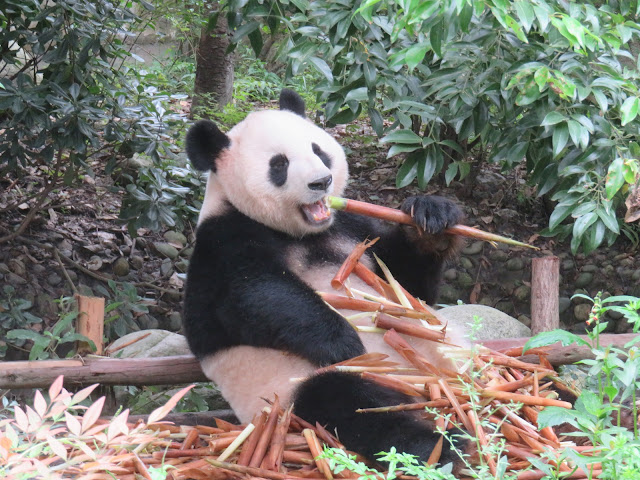 |
| Their diet consists almost entirely of bamboo and they eat as much as 20 to 30 lbs of bamboo shoots a day. |
 |
| Baby pandas |
 |
| Red pandas also known in China as racoons |
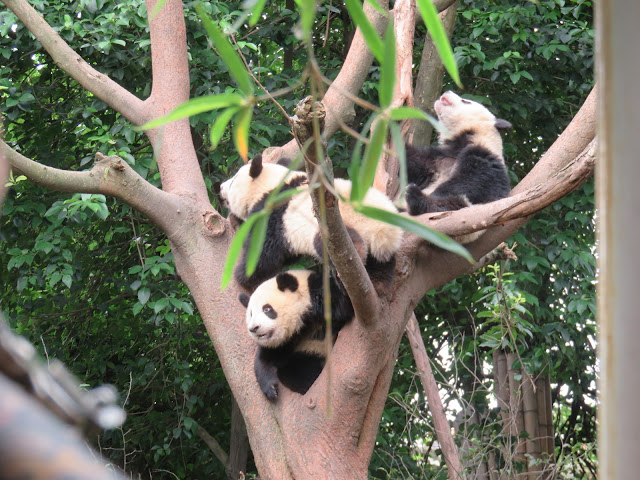 |
| Pandas playing |
 |
| What I consider China's national treasure - their beautiful children! |
 |
| We went for a walk in Chengdu to see a statue of Mao. Only 8 cities still have statues of him. |
 |
| It seemed very fitting that the statue faces this display of capitalism across the street - the one thing he tried his best to destroy. |
 |
| Tea ceremony prior to the Sichuan Opera. This opera began during the Qing Dynasty (1644-1911). It included traditional music, fire-breathing and face-changing (which was amazing). |
 |
| Shadow puppetry |
 |
| Stick puppet performance |
 |
| The costumes and make up were incredible. |
 |
| A beautifully coloured dragonfly (I think) |
 |
| All the trucks in China were cab-overs. This was one of the longest truck/trailer units we saw. |
 |
| By day these poles in the city of Xi'an were quite ugly. At night they came alive and were just beautiful. |
 |
| Dancing water fountain display is held each night in Xi'an |
 |
| On our way back to the hotel, we saw these people dancing in the square. They were so much fun to watch. Behind them were dozens of couples waltzing to the music. |
 |
| Giant Wild Goose Pagoda by night |
 |
| The heads and hands were made separately and each head is unique with individual features and facial expressions.They vary in height, uniform and hairstyle according to their rank. |
 |
| It is an amazing sight! |
 |
| The original roofs of the pits collapsed and crushed the army figures below. The figures currently on display have been restored from the fragments. |
 |
| The tedious job of reconstructing the warriors and horses from the fragments. |
 |
| My terra cotta warrior |
 |
| Our evening show in Xi'an told the story of a concubine who became the first (and only) Empress of China during the Tang dynasty. This is the Warriors' Triumphal Dance. |
 |
| The music, costumes, dancing and backdrops were amazing. |
 |
| The final scene - the Empress of China |
 |
| Traffic in Beijing - the worst we've ever seen. |
 |
| We went for a rickshaw ride while we were in the hutong. |
 |
| One of our stops in the hutong was in a tea shop for a tea tasting ceremony. |
 |
| Adding tea to a tiny cup and pressing it to your face is supposed to improve your complexion. I thought we just looked ridiculous! |
 |
| Her niece is carrying on the tradition of "inside painting". |
 |
| Our first glimpse of the Great Wall from the bus! The Wall is 5500 miles (8850 km) long, but much of it has disappeared due to erosion, vandalism and theft |
 |
| You can see how steep it is! I was grateful for the hand rails! |
 |
| View of the wall from one of the watchtower windows. |
 |
| Slowly making my way up the wall. |
 |
| The first watchtower where you could have a small plaque engraved with your name and the date stating "I climbed the Great Wall"! |
 |
| Taking a rest along the way. |
 |
| The last leg of the route was much less busy. The watchtower at the end was as far as we were allowed to go. |
 |
| On our way down. Even the little children were climbing it! Another item off of our bucket list! |
 |
| Modern architecture in Beijing |
 |
| Reminders of the 2008 Beijing Summer Olympics (and more cranes)! |
 |
| The Beijing Olympic Stadium (known as the Bird's Nest) and the Beijing National Aquatics Centrer (the Water Cube) |
 |
| We stopped for lunch at the Run-Ze Jade Garden. Here we saw artisans creating jade puzzle balls aka "happy balls" from pieces of jade. |
 |
| An intricately carved jade galleon |
 |
| Beijing traffic jam |
 |
| Look at all the people waiting for buses after work! |
 |
| Tiananmen Square - once the entrance to the Forbidden City. It is 100 acres in size, one of the world's largest public squares. It can accommodate a million people. |
 |
| Guard standing at attention in Tiananmen Square. They work 2-hour shifts standing at complete attention. |
 |
| Tiananmen Gate - it is here Mao Zedong announced the founding of the People's Republic of China in 1949. |
 |
| Court yard in the Outer Court |
 |
| Palace of Heavenly Peace (I think) |
 |
| Part of the Inner Palace |
 |
| Through the grimy windows, you could see ceramic pieces and palace artifacts. |
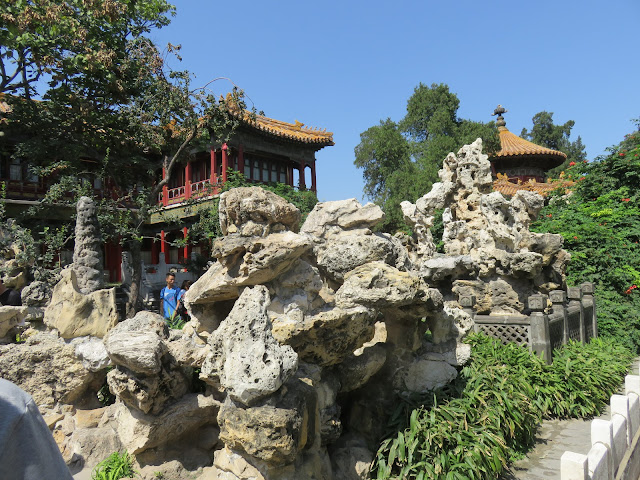 |
| The Imperial Garden |
 |
| Our guide told us that this was the palace where the concubines were trained to please the emperor. |
 |
| On our last night we went to see the "Legend of Kung Fu" at the Red Theatre. |
 |
| The story followed the life of the young monk, Chun Yi, as he meets many mental physical and mental challenges on the way to becoming a Kung Fu master. It was an amazing display of martial arts. |


